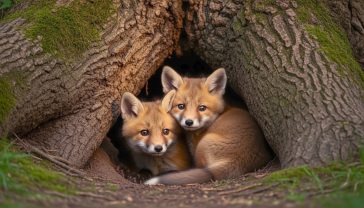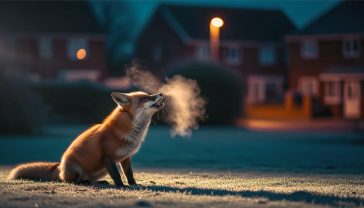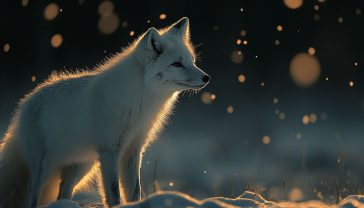When Are Fox Cubs Born? A Complete Guide to Their Secret First Months
When do fox cubs appear? This definitive guide details the complete timeline of fox cub development, from blind newborns in spring to their first steps outside the den.

This post may contain affiliate links. If you make a purchase through these links, we may earn a commission at no additional cost to you.
It’s a sight that stops you in your tracks. A flash of a russet tail darting behind a garden shed at twilight, or a pair of amber eyes watching you from the end of an allotment. The red fox is the UK’s most common and captivating carnivore, a master of survival that has made our towns, cities, and countryside its home. But while the adults are a familiar sight, their offspring are a far more secretive affair.
You’ve probably seen a lone fox trotting confidently down your street late at night and wondered: where is its family? Does it have cubs? And if so, when do they actually appear?
The journey of a fox cub from a tiny, helpless creature to a cunning adolescent is one of nature’s most fascinating stories, and it happens right under our noses every year. This guide will pull back the curtain on that secret world. We’ll explore the complete timeline, from the strange, screeching calls of the winter mating season to the moment the young cubs finally take their first wobbly steps into the great outdoors. Whether you’re a curious wildlife lover or simply want to know what’s happening in your own back garden, this is the definitive guide to the birth and development of British fox cubs.
The Fox’s Calendar: Mating Season and Finding a Home
Before we can welcome the cubs, we need to understand how their story begins. The fox’s year is a tightly run schedule, and it all kicks off in the dead of winter.
The Winter Romance: When Foxes Mate
While we’re huddled indoors escaping the cold, Britain’s foxes are at their most social. Their mating season typically runs from December to February. This is when you’re most likely to hear the fox’s most startling and often misunderstood call: the vixen’s scream.
It’s an eerie, high-pitched sound that can easily be mistaken for a person in distress. But this is the vixen’s way of signalling to male foxes, known as dog foxes, that she is ready to mate. The dog fox will answer with his own sharp, triple-bark call. For a few weeks, our countryside and city suburbs are filled with this strange, nocturnal conversation.
A vixen will usually only be receptive to mating for a very short period—just three to five days during her cycle. During this time, a dog fox will stay close by her, and they will hunt and travel together. Once they have mated successfully, the clock starts ticking.
Preparing the Nursery: The Fox ‘Earth’
A pregnant vixen needs a safe, secure place to give birth. This den is traditionally called an ‘earth’ or a ‘holt’. She won’t dig a new one if she can help it; foxes are opportunists. Instead, she’ll seek out a ready-made home.
In rural areas, this might be an abandoned badger sett, a hollow log, or a sheltered burrow in a thicket. In our towns and cities, however, they get a bit more creative. The most popular urban den sites include:
- Underneath garden sheds or decking: This is a classic. It’s dry, dark, and provides a solid roof.
- In overgrown corners of gardens or allotments: A dense bramble patch or a forgotten compost heap is a perfect nursery.
- Within railway embankments or on scrubland: These quiet, undisturbed areas are ideal.
- Under the foundations of buildings: Sometimes, they’ll even set up shop in the voids beneath garages or conservatories.
The vixen is incredibly secretive during this time. She’ll prepare the den, clearing out debris and ensuring it’s safe, often without the homeowner ever knowing she’s there. Her pregnancy, known as the gestation period, is surprisingly short. It lasts for just 51 to 53 days—a little under two months.
So, if mating happens in January, you can expect the pitter-patter of tiny paws to arrive very soon.
The Big Arrival: When Are Fox Cubs Actually Born?
This is the question at the heart of our guide. After a winter of courtship and a brief pregnancy, the vixen disappears into her chosen earth to give birth.
The Peak Season: Springtime is Cub Time
The overwhelming majority of fox cubs in the UK are born in the spring. The peak period is from mid-March to the end of April. It’s not uncommon for some litters to arrive a little earlier in February if the winter has been mild, while others might be born as late as May.
This timing is no accident. Spring is the perfect season for raising a family. Here’s why:
- Abundant Food: As the weather warms up, the world comes alive. Earthworms, beetles, and other insects become plentiful. Young rabbits and fledgeling birds are easier to catch. This provides the vixen with the high-protein diet she needs to produce milk and, later, to feed her growing cubs.
- Warmer Weather: Newborn cubs cannot regulate their own body temperature. Being born in the spring means they avoid the harshest winter cold, giving them a much better chance of survival.
- Increased Cover: As leaves return to the trees and undergrowth becomes thicker, it provides better camouflage for the den and for the cubs when they eventually start to explore.
A typical litter size is four or five cubs, though it can be as few as one or as many as eight. The vixen gives birth to them alone in the darkness of the earth, and for the first few weeks of their lives, this tiny, dark space will be their entire world.
A Week-by-Week Guide to Fox Cub Development
A newborn fox cub is a world away from the sharp, intelligent-looking creature we know. Its transformation over the first few months is nothing short of remarkable. Here’s a detailed look at their secret first weeks.
Week 1: The Newborn Stage (Blind, Deaf, and Helpless)
When a fox cub is born, it is completely dependent on its mother. It’s tiny, weighing only about 100 grams—roughly the weight of a bar of soap.
- Appearance: They look more like tiny puppies than foxes. Their fur is short, thick, and a dark, chocolatey-brown or charcoal grey. There’s no sign of the famous red coat yet. Their snouts are short and stubby, and their tails are thin with no white tip.
- Senses: They are born blind and deaf. Their eyes and ears are sealed shut. Their world is one of darkness, warmth, and the smell of their mother and siblings.
- Behaviour: Their only instincts are to seek warmth and milk. They spend their days huddled together in a pile for heat while the vixen curls around them. They can’t even regulate their own body temperature yet, so their mother’s body heat is essential for survival. She will not leave the den for the first week, relying on her partner to bring her food.
Weeks 2-3: Senses Awaken
This is a period of huge change. At around 14 days old, the cubs’ eyes begin to open. At first, they are a cloudy, milky-blue colour and their vision is poor. A few days later, their ear canals will open too, and they will hear for the first time.
- Appearance: Their fur starts to get a little longer, and you might see the first reddish tinges appearing around their faces. Their snouts begin to elongate, and they start to look slightly more fox-like.
- Behaviour: With their senses now online, they become more aware of their surroundings. They’ll start to crawl and shuffle around the den, exploring its dark corners. You’ll hear them making little whimpering and squeaking noises as they interact with each other. They are still entirely reliant on their mother’s milk.
Weeks 4-5: First Steps Outside the Den
This is the moment many wildlife watchers hope to witness. At around four to five weeks old, filled with growing confidence and curiosity, the cubs will take their first wobbly steps out of the earth.
- Appearance: The transformation is now well underway. Their dark puppy fur is being replaced by a fluffy, reddish-brown coat. Their blue eyes are gradually changing to the piercing amber they’ll have as adults. The iconic white tip on their tail usually becomes visible around this time.
- Behaviour: Their first forays outside are usually brief and happen at dawn or dusk. They stick very close to the den’s entrance, ready to dive back underground at the slightest sign of danger. This is when their playful side emerges. They will pounce on each other, tumble around, and play-fight—all crucial practice for learning the skills of stalking and hunting.
- Diet: The vixen will start to wean them off her milk. She does this by regurgitating partially digested food for them. It might not sound appealing, but it’s the perfect way to introduce them to meat. The dog fox will also be working overtime, bringing prey like mice, pigeons, or scraps from bins back to the den for the family.
Weeks 6-8: Weaning and Learning the Ropes
The cubs are now spending more and more time outside the den. Their playground expands from the entrance to the wider surrounding area.
- Appearance: They now look like perfect miniature foxes. Their red coat is much more developed, though still fluffier and scruffier than an adult’s. Their legs and snouts are longer, making them look a little gangly and awkward.
- Behaviour: Play becomes more sophisticated. They’ll stalk and pounce on insects, leaves, or their siblings’ tails. They learn key fox body language, like the submissive crouch or the aggressive posture. Their mother and father will bring them live prey, such as a stunned mouse, so they can practice their killing bite. It’s a tough lesson, but a vital one.
- Diet: They are now almost fully weaned and eating solid food provided by their parents. Their teeth are sharp, and they can tear apart food for themselves.
Months 3-4: The Teenagers of the Fox World
By the time summer arrives, the cubs are well-grown and full of boundless energy. They are essentially fox teenagers.
- Appearance: They are almost the same size as their parents, though a little leaner. Their adult coat is coming through, and they are starting to look much sleeker.
- Behaviour: The family unit is still strong, but the cubs are now learning to forage for themselves. They will follow their parents on hunting trips, watching and learning. They’ll explore the boundaries of their territory, learning where the best food sources are and where the dangers lie. A clear social hierarchy, or ‘pecking order’, will have been established among the siblings through their endless play-fighting.
Months 5-7: Dispersal and Adulthood
As late summer turns to autumn, the family bond begins to weaken. The time has come for the cubs to strike out on their own. This process is called dispersal.
- Behaviour: From about September onwards, the young foxes will leave their parents’ territory to find their own patch. This is a dangerous and uncertain time. They have to navigate unfamiliar ground, cross busy roads, and avoid rival adult foxes who will aggressively defend their own territories.
- Survival: Sadly, not all of them will make it. It’s estimated that over half of all fox cubs die within their first year. For those that do succeed, they will find a vacant territory and, by the following winter, they will be ready to find a mate and start the cycle all over again.
The Fox Family: Roles, Sounds, and Social Life
A fox den isn’t just a nursery; it’s the centre of a complex family unit where each member has a role to play.
The Vixen’s Role: A Devoted Mother
The vixen is the heart of the family. For the first few weeks, she is a constant presence, providing milk, warmth, and security. As the cubs grow, her role shifts from nurse to teacher. She teaches them what is safe to eat, how to behave around other foxes, and how to hunt. Her life is dedicated to their survival.
What About the Dog Fox? The Supportive Dad
Contrary to some myths, the dog fox is not an absent father. He plays a crucial role. While the vixen is confined to the den with the newborns, he is the sole provider. He tirelessly hunts and brings food back for his mate. Once the cubs are older, he helps feed them and stands guard over the den, barking to warn of any potential threats like dogs or people. He also participates in their education, playing with them and teaching them vital skills.
Fox Cub Communication: What Do Those Noises Mean?
A fox den in spring is a noisy place. Cubs have a range of sounds they use to communicate with their parents and siblings.
- Whimpering/Squeaking: These are contact calls, used when they are very young to get their mother’s attention.
- Yapping/Gekkering: As they get older and start to play, you’ll hear excited, chattering yaps. This is the sound of them play-fighting and establishing their social order.
- Alarm Barks: If a cub is startled or feels threatened, it will let out a sharp, high-pitched bark to alert the rest of the family to danger.
Urban vs. Rural Cubs: A Tale of Two Foxes
While the developmental stages are the same, life for a fox cub can be very different depending on whether it’s born in a bustling city or the quiet countryside.
Urban cubs often grow up in smaller territories. Food can be easier to come by, with a reliable supply of discarded takeaways, pet food left out in gardens, and overflowing bins. However, they face immense danger from traffic, which is the single biggest killer of urban foxes. They also have to learn to navigate a complex world of fences, walls, and curious humans.
Rural cubs learn to hunt natural prey from a much earlier age. Their territories are larger, and they are less likely to encounter people. However, they face different threats. They may be seen as a pest by farmers, and they have to contend with gamekeepers, farm machinery, and a greater number of natural competitors.
Common Questions and How You Can Help
Seeing fox cubs in your garden can be a magical experience, but it also comes with questions and responsibilities. Here’s some clear, safe advice.
I’ve Found a Fox Cub! What Should I Do?
It’s common to see a lone cub and assume it’s been abandoned. In most cases, it hasn’t. The vixen is probably nearby, waiting for you to leave.
- Do Not Touch It. First and foremost, never touch or move a fox cub unless it is in immediate, life-threatening danger (like in the middle of a road). Handling it will leave your scent on it, which can cause the vixen to reject it.
- Observe from a Distance. Find a place where you can watch from afar, preferably from inside your house. Keep pets and people away from the area.
- Wait and Watch. The vixen is a nervous parent. She may have been in the process of moving her cubs to a new den one by one, or she may simply be out hunting. Give her plenty of time—at least a few hours—to come back for her cub.
- When to Call for Help. If the cub is obviously injured, sick (e.g., covered in flies, very lethargic), or is in a dangerous location, it’s time to intervene. Likewise, if many hours have passed and the mother has not returned, the cub may need help. Call your local wildlife rescue centre or the RSPCA (0300 1234 999) for advice. They will tell you what to do. Never try to raise a fox cub yourself. It is a wild animal with complex needs, and it is illegal to keep one without the proper license.
Should I Feed Fox Cubs in My Garden?
The simple answer is no. While it comes from a good place, feeding fox cubs can do more harm than good.
- It creates dependency. They need to learn to find food for themselves. If they get used to a free handout, they won’t develop the crucial survival skills they need.
- You might give them the wrong food. Things like bread and milk can make them very ill.
- It can cause conflict. A regular food source can attract large numbers of foxes to one area, leading to fights and the spread of disease. It can also cause problems with neighbours who may not appreciate a nightly gathering of foxes.
The best way to help is to let their parents raise them naturally.
Conclusion: The Enduring Charm of the British Fox
The journey of a fox cub, from a blind and helpless newborn in a dark, earthy den to a sharp-witted survivor, is a drama that unfolds across Britain every spring. For a few short months, our gardens, parks, and hedgerows become the playgrounds and classrooms for the next generation.
By understanding their timeline and their behaviour, we can better appreciate the challenges these remarkable animals face. The red fox remains one of our most resilient and adaptable creatures, a symbol of a wildness that thrives right on our doorstep. The next time you see that flash of a russet tail in the twilight, you’ll know the deep and complex story that brought it there.
Further Reading
For those who wish to learn more, these organisations offer a wealth of expert information and advice:
- The Wildlife Trusts: A nationwide network dedicated to conserving UK wildlife, with excellent resources on foxes.
- The RSPCA (Royal Society for the Prevention of Cruelty to Animals): The first port of call for advice on sick or injured wildlife.
- The Fox Project: A registered charity and specialist wildlife hospital dedicated to the red fox.






